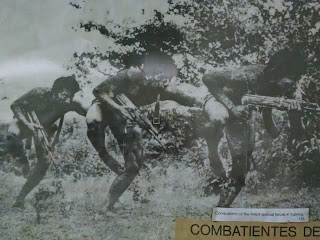One of the biggest take-aways for me was getting a better sense of the people who stay behind. Up until this trip, of course, my understanding came only from what my students had told me. I imagined a country virtually populated only with children, abuelas and tias. This is not the case. A more realistic picture began to emerge after we left San Salvador and headed into Morozon. Our students, the ones who leave, are not the leaders, so it was somewhat surprising to see that there are many strong leaders in the small villages. Our first encounter was a lovely gathering with members of a pastoral community. We gathered in the church, formed a circle and sang the song "Solidaridad." Among many topics, Maria, the primary spokesperson for the group, talked about how the
communities are left fractured and diminished when someone leaves, not just families.
This same concern was echoed by the community leaders of Amando Lopez and Monte Cristo. However, unlike our students, who see the solution to a better life in the U.S., these people have made a conscious decision to stay and do the best they can to provide a better future for their children
in El Salvador. It was very helpful to have the opportunity
to talk to the leaders of San Luis, Amando Lopez and Monte Cristo and to know that there are people remaining in the country who struggle against great odds every day to build opportunities for their families right there.
San Luis
San Luis
Amando Lopez
Monte Cristo
Monte Cristo
Another significant experience of the trip, that added to the big picture, was staying with families. I have to admit that this was the part of the trip I was most anxious about. It's very demanding to be a guest in a stranger's home under "normal" circumstances, but being a guest in a stranger's home in another country, speaking another language is a whole different ballgame. Again, my vision of a typical Salvadoran home came from descriptions from my students, so I had a little idea of what to expect, but "living" it, even for just 2 days, gave me a more realistic picture of what their daily lives had been like: cooking over an open fire, bathing at a concrete sink with a basin, washing dishes at the concrete sink, sleeping in a hammock, washing clothes in the river, and going to the bathroom in an outhouse. It was important to experience this first hand, if only for a short period of time.






Jeanne Rikkers also added some insight into the dynamics of leaving vs staying. We see our students as making a huge sacrifice by leaving their children behind to find jobs in the U.S. so they can provide for these children. But she sees children who feel abandoned by their parents; children who don't care about the material things their parents provide by sending back money, they just want their mother or father with them.
Jeanne Rikkers
Parents who leave also tend to paint a rosy picture of their new life in the U.S. (even though the reality is that their new life is really hard) because they don't want their families to worry about them. Rather than alleviating the worry, it has the effect of causing resentment in the family left behind. Jeanne feels it would be better if the parents would be more honest about how difficult their life in the U.S. really is.
Jeanne also suggested that often times young mothers are secretly relieved to leave their children behind and start a new life in the U.S. although it is never spoken. Of course they love their children, but they see an opportunity to leave an oppressive country where the primary objective of women is to simply bear children.
So I now have a more complete notion of the immigration picture and it's effects here at home and in El Salvador. It's not pretty. I only hope it helps me, helps us all, be more aware, sympathetic, and ultimately more effective as teachers and counselors.
.



















































